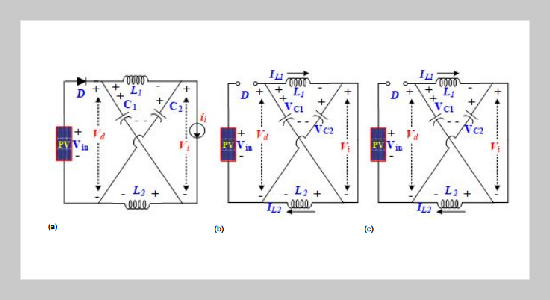N. Kalaiarasi1, Subhranshu Sekhar Dash2, S. Paramasivam3, and C. Bharatiraja This email address is being protected from spambots. You need JavaScript enabled to view it.1
1Department of Electrical and Electronics Engineering, SRM Institute of Science and Technology ,SRM Nagar, Kattankulathur, 603203, Kanchipuram, Chennai, TN, India
2Government College of Engineering, Keonjhar, Odisha, India
3Danfoss Industries Ltd, Chennai, Tamilnadu, India
REFERENCES
- [1] Tarak Salmi, Mounir Bouzguenda, Adel Gastli, and Ahmed Masmoudi. MATLAB/simulink based modelling of solar photovoltaic cell. International Journal of Renewable Energy Research, 2(2):213–218, 2012.
- [2] Fang Zheng Peng. Z-source inverter. IEEE Transactions on Industry Applications, 39(2):504–510, mar 2003.
- [3] Yam P. Siwakoti, Fang Zheng Peng, Frede Blaabjerg, Poh Chiang Loh, and Graham E. Town. Impedancesource networks for electric power conversion Part I: A topological review. IEEE Transactions on Power Electronics, 30(2):699–716, 2015.
- [4] Po Xu, Xing Zhang, Chong Wei Zhang, Ren Xian Cao, and Liuchen Chang. Study of Z-source inverter for gridconnected PV systems. In PESC Record - IEEE Annual Power Electronics Specialists Conference, 2006.
- [5] Miao Zhu, Kun Yu, and Fang Lin Luo. Switched inductor Z-source inverter. IEEE Transactions on Power Electronics, 25(8):2150–2158, 2010.
- [6] Boris Axelrod, Yefim Berkovich, and Adrian Ioinovici. Switched-capacitor/switched-inductor structures for getting transformerless hybrid DC-DC PWM converters. IEEE Transactions on Circuits and Systems I: Regular Papers, 55(2):687–696, 2008.
- [7] Yu Tang, Shaojun Xie, Chaohua Zhang, and Zegang Xu. Improved Z-source inverter with reduced Z-source capacitor voltage stress and soft-start capability. IEEE Transactions on Power Electronics, 24(2):409–415, 2009.
- [8] Yam P. Siwakoti, Frede Blaabjerg, and Poh Chiang Loh. New Magnetically Coupled Impedance (Z-) Source Networks. IEEE Transactions on Power Electronics, 31(11):7419–7435, 2016.
- [9] Madasamy Periyanayagam, V. Suresh Kumar, Bharatiraja Chokkalingam, Sanjeevikumar Padmanaban, Lucian Mihet-Popa, and Yusuff Adedayo. A modified high voltage gain quasi-impedance source coupled inductor multilevel inverter for photovoltaic application. Energies, 13(4), 2020.
- [10] C. Bharatiraja, P. Sanjeevikumar, Aganti Mahesh, Ayushi Saxena, K. Padmapriya, B. K. Mithra, A. S. Swathimala, and S. Raghu. Analysis, design and investigation on a new single-phase switched quasi Z-source inverter for photovoltaic application. International Journal of Power Electronics and Drive Systems, 8(2):853–860, jun 2017.
- [11] T.K.S Sathayanarayanan, M Ramasamy, C Bharatiraja, and JL Munda. Modelling, Impedance Design, and Efficiency Analysis of Battery Assists PV tied Quasi-Z source inverter. International Journal of Power Electronics and Drive Systems (IJPEDS), 7(3):816, sep 2016.
- [12] Chokkalingam Bharatiraja and J L Munda. Simplified SVPWM for Z Source T-NPC-MLI including neutral point balancing. In ISCAIE 2016 - 2016 IEEE Symposium on Computer Applications and Industrial Electronics, pages 132–138, 2016.
- [13] Ms Kamalesh, Nattuthurai Senthilnathan, and Chokkalingam Bharatiraja. Design of a Novel Boomerang Trajectory for Sliding Mode Controller. International Journal of Control, Automation and Systems, 18(11):2917–2928, 2020.
- [14] M Karthikeyan, R Elavarasu, P Ramesh, C. Bharatiraja, P. Sanjeevikumar, Lucian Mihet-Popa, and Massimo Mitolo. A hybridization of cuk and boost converter using single switch with higher voltage gain compatibility. Energies, 13(9), 2020.
- [15] M. Venmathi, V. Krishnakumar, C. Bharatiraja, and V. Vasanprabhu. A Modified Buck-Boost Zero Voltage Switching Converter for Photo-voltaic Applications. In Proceedings of 2018 IEEE International Conference on Power Electronics, Drives and Energy Systems, PEDES 2018. Institute of Electrical and Electronics Engineers Inc., jul 2018.
- [16] Chokkalingam Bharatiraja, Sanjeevikumar Padmanaban, Pierluigi Siano, Zbigniew Leonowicz, and Atif Iqbal. A hexagonal hysteresis space vector current controller for single Z-source network multilevel inverter with capacitor balancing. In Conference Proceedings - 2017 17th IEEE International Conference on Environment and Electrical Engineering and 2017 1st IEEE Industrial and Commercial Power Systems Europe, EEEIC / I and CPS Europe 2017, 2017.
- [17] Bidyadhar Subudhi and Raseswari Pradhan. A comparative study on maximum power point tracking techniques for photovoltaic power systems. IEEE transactions on Sustainable Energy, 4(1):89–98, 2012.
- [18] A Mellit, S. A. Kalogirou, L. Hontoria, and S. Shaari. Artificial intelligence techniques for sizing photovoltaic systems: A review, 2009.
- [19] Yeong Chau Kuo, Tsorng Juu Liang, and Jiann Fuh Chen. Novel maximum-power-point-tracking controller for photovoltaic energy conversion system. IEEE Transactions on Industrial Electronics, 48(3):594–601, 2001.
- [20] Hafedh Abid, Ines Zaidi, Ahmed Toumi, and Mohamed Chaabane. T-S Fuzzy Algorithm for Photovoltaic Panel. International Journal of Fuzzy Systems, 17(2):215–223, jun 2015.
- [21] S Karthika, P Rathika, and D Devaraj. Fuzzy Logic Based Maximum Power Point Tracking Designed for 10kW Solar Photovoltaic System. International Journal of Computer Science and Management Research, 2(2):1421– 1427, 2013.
- [22] Syafaruddin, E Karatepe, and T. Hiyama. Artificial neural network-polar coordinated fuzzy controller based maximum power point tracking control under partially shaded conditions. IET Renewable Power Generation, 3(2):239–253, 2009.
- [23] T.L. Kottas, Y.S. Boutalis, and A.D. Karlis. Maximum Power Point Tracker for PV Arrays Using Fuzzy Controller in Closed-loop operation With Fuzzy Cognitive Networks. IEEE Transaction on Energy Conversion, 21(3):793–803, 2006.
- [24] N. Kalaiarasi, S. Paramasivam, and Sanchari Kundu. Control of Z-source inverter based PV system with MPPT using ANFIS. International Review on Modelling and Simulations, 7(5):797–806, oct 2014.
- [25] Haitham Abu-Rub, Atif Iqbal, Sk Moin Ahmed, Fang Z. Peng, Yuan Li, and Ge Baoming. Quasi-Zsource inverter-based photovoltaic generation system with maximum power tracking control using ANFIS. IEEE Transactions on Sustainable Energy, 4(1):11–20, 2013.









